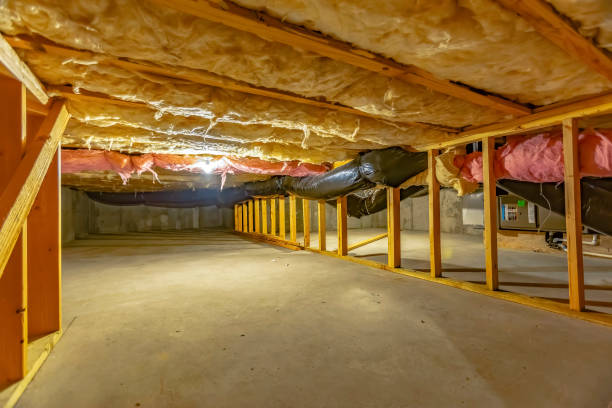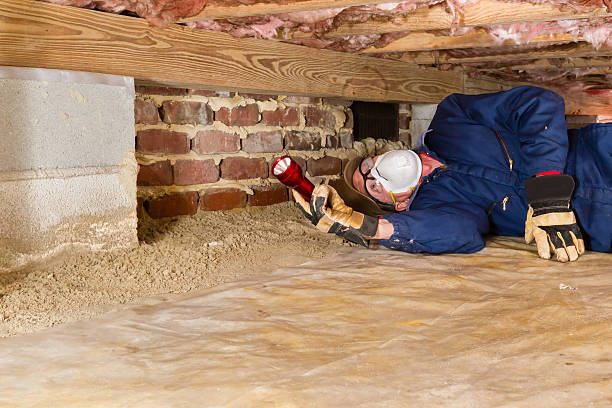- Dirt-floor crawl spaces require a vapor barrier before insulation.
- Rigid foam is the most reliable option for moisture resistance and cost-effectiveness.
- Spray foam delivers the best seal but is expensive and professional-only.
- Fiberglass is budget-friendly but prone to mold and pests.
- Insulating crawl space walls is often more effective than insulating the floor.
When your home has a crawl space with a dirt floor, keeping it insulated isn’t just a comfort issue—it’s a necessity. Without proper insulation, your crawl space can become a breeding ground for moisture, pests, and drafts that creep up into your living spaces. On top of that, poorly insulated crawl spaces cause higher energy bills and put stress on your heating and cooling systems.
But here’s the real challenge: not all insulation types are created equal, especially when dealing with bare soil. Three of the most common options are rigid foam, spray foam, and fiberglass, each with unique pros and cons. This article dives deep into which one could be the best insulation for crawl space with dirt floor conditions.
Let’s compare them side by side so you can make a decision that balances cost, effectiveness, and long-term durability.
Why Does Crawl Space Insulation Matter?
If you’ve ever walked barefoot across your floor in the winter and felt the chill, chances are your crawl space is part of the problem. A dirt-floor crawl space allows ground moisture and cold air to move freely unless it’s sealed and insulated properly.
Insulation matters because it:
- Reduces moisture that can lead to mold, mildew, and wood rot.
- Improves energy efficiency by preventing conditioned air from escaping.
- Keeps floors warmer in winter and cooler in summer.
- Protects plumbing from freezing in colder months.
- Blocks pests like rodents or insects that thrive in damp, unsealed spaces.
Without insulation, your crawl space can act like an open window under your home—pulling in damp air and spreading it upward through a process called the stack effect.
What Makes Dirt-Floor Crawl Spaces Different?
If your crawl space had a concrete slab or was fully sealed, insulation would be more straightforward. Dirt floors complicate things because they naturally release ground moisture. Without a vapor barrier—a thick plastic sheeting placed directly on the dirt—you’ll constantly fight condensation, mold, and musty smells.
Before insulating, it’s essential to:
- Lay down a vapor barrier to cover the soil.
- Check for drainage issues or standing water.
- Seal air leaks around vents, rim joists, and wall penetrations.
Once that’s done, you can focus on choosing the best insulation for crawl space with dirt floor.
Which Insulation Types Work Best in Crawl Spaces?

The three most debated options are rigid foam, spray foam, and fiberglass. Each has strengths, but also drawbacks, especially in damp, dirt-floored conditions.
Let’s break them down.
What Is Rigid Foam Insulation?
Rigid foam boards are panels made of polystyrene, polyisocyanurate, or polyurethane. They come in sheets and are cut to size to fit against crawl space walls or between joists.
Pros of Rigid Foam
- Excellent moisture resistance: Doesn’t absorb water like fiberglass.
- Long lifespan: Can last decades when installed correctly.
- High R-value per inch: Offers solid thermal performance.
- Deters pests: Harder for rodents to nest in.
- DIY-friendly: Easier to cut and install compared to spray foam.
Cons of Rigid Foam
- Higher upfront cost: More expensive than fiberglass.
- Seams need sealing: Gaps must be taped or foamed for air-tightness.
- Requires precise installation: Any missed gaps reduce effectiveness.
Best Use for Rigid Foam
Rigid foam works best for lining crawl space walls instead of insulating between the floor joists. When combined with a vapor barrier, it creates a strong thermal and moisture shield.
What Is Spray Foam Insulation?
Spray foam comes in two main types: open-cell and closed-cell. For crawl spaces, closed-cell spray foam is preferred because it’s denser, resists moisture, and adds structural strength.
Pros of Spray Foam
- Air- and moisture-tight: Expands to seal every crack and gap.
- High R-value per inch: Provides excellent insulation with less material.
- Mold-resistant: Closed-cell foam resists water absorption.
- Durable: Can last 20+ years without losing effectiveness.
Cons of Spray Foam
- Expensive: The most costly insulation option.
- Professional installation required: DIY isn’t recommended due to equipment and safety concerns.
- Hard to remove: Once sprayed, it’s permanent.
- Not rodent-proof: Determined pests may still chew through it.
Best Use for Spray Foam
Spray foam is ideal for sealing rim joists, wall penetrations, and small spaces where rigid foam might not fit perfectly. It’s also a strong contender for fully encapsulating crawl space walls if you’re investing in a long-term solution.
What About Fiberglass Insulation?
Fiberglass batts are the traditional go-to for insulation. They’re affordable, widely available, and easy to install between floor joists. But in crawl spaces with dirt floors, fiberglass has a poor track record.
Pros of Fiberglass
- Lowest upfront cost: Budget-friendly.
- Widely available: Found at any home improvement store.
- Easy to install: Simple DIY option.
Cons of Fiberglass
- Absorbs moisture: Leads to sagging, mold, and odor.
- Pest-friendly: Rodents love nesting in fiberglass.
- Short lifespan: Often needs replacement within 5–10 years.
- Inefficient in humid spaces: Loses R-value when damp.
Best Use for Fiberglass
If you must use fiberglass, it’s best only in dry, well-ventilated crawl spaces—and even then, it should be installed with caution. Most experts discourage using it directly over dirt-floor crawl spaces.
Which Is the Best Insulation for Crawl Space with Dirt Floor?
If we compare rigid foam, spray foam, and fiberglass, here’s how they stack up:
- Rigid Foam: Best balance of performance, cost, and DIY potential.
- Spray Foam: Best long-term and airtight solution, but at a premium price.
- Fiberglass: Cheapest, but risky for dirt-floor crawl spaces due to moisture issues.
Quick Comparison Table
| Feature | Rigid Foam | Spray Foam | Fiberglass |
| Moisture Resistance | High | Very High | Low |
| Pest Resistance | Moderate | Low | Very Low |
| R-Value | 4–6 per inch | 6–7 per inch | 2–3 per inch |
| Cost | $$ | $$$$ | $ |
| DIY-Friendly | Yes | No | Yes |
| Lifespan | 20–30 years | 20+ years | 5–10 years |
Should You Insulate the Floor or the Walls?
A common question is whether to insulate the crawl space ceiling (the underside of your floors) or the walls.
- Floor insulation: Works if your crawl space is vented and exposed to outside air.
- Wall insulation: Better for unvented or encapsulated crawl spaces, keeping the entire area warmer and drier.
Most modern building experts recommend insulating the walls and laying a vapor barrier on the dirt floor. This keeps the crawl space within the home’s conditioned envelope and reduces moisture problems.
How Much Does Crawl Space Insulation Cost?

Here’s a ballpark estimate for each type:
- Rigid Foam: $2–$5 per square foot installed.
- Spray Foam: $3–$7 per square foot installed.
- Fiberglass: $0.50–$2 per square foot installed.
While fiberglass is cheaper upfront, it may need replacement sooner, making it more costly in the long run. Rigid foam and spray foam require more investment but save money on energy bills over time.
Can You DIY Crawl Space Insulation?
It depends on the material:
- Rigid Foam: Yes, with basic tools and patience. You’ll need to cut panels, attach them with adhesive or fasteners, and seal seams with tape or spray foam. If you’re researching how to insulate a crawl space on your own, rigid foam is often the easiest and most reliable option.
- Spray Foam: No, unless you’re highly experienced. Professional installation is the norm.
- Fiberglass: Yes, but it comes with risks if the crawl space is damp. Always wear protective gear to avoid irritation.
Common Mistakes to Avoid
Even the best insulation for crawl space with dirt floor won’t work if installed incorrectly. Watch out for these pitfalls:
- Skipping the vapor barrier on the dirt floor.
- Leaving air gaps between insulation panels.
- Using fiberglass in damp crawl spaces.
- Not sealing rim joists and wall penetrations.
- Ignoring existing drainage problems.
Final Verdict: Which One Should You Choose?
If you want the best insulation for crawl space with dirt floor, here’s the bottom line:
- Best overall: Rigid foam, especially for DIY homeowners.
- Best long-term premium choice: Closed-cell spray foam for airtight encapsulation.
- Best budget choice: Fiberglass, but only in dry, low-moisture conditions.
Your decision should factor in climate, budget, and whether your crawl space is vented or encapsulated. In most cases, rigid foam paired with a vapor barrier gives the best mix of protection and affordability.

